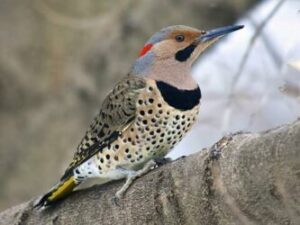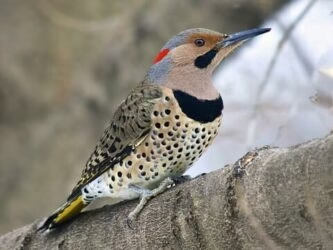Why Do Woodpeckers Peck Trees? Woodpeckers are often heard before they are seen.
If you are lucky enough to see them at all. That drumming sound is both unmistakable and intriguing.

So, why do woodpeckers peck trees and how are they able to do so with such ease?
Why Do Woodpeckers Peck Trees?
Woodpeckers peck at trees for a variety of reasons. Making good use of their physical adaptation.
And taking advantage of their niche in the environment. They peck in order to.
- Obtain food that would be out of reach to other birds
- Excavate cavities in the tree for nesting and,
- Communicate with other birds.
Woodpeckers Pecking At Trees For Food.
Every bird bill is designed to suit the diet of that species.
That is why there are so many different types with various lengths, shapes, and other adaptions.
Seed-eaters will have strong short bills, and meat-eaters often have sharp hooks for tearing at flesh.
And insect-eaters can have long probing bills for extracting food from under the sand.
The woodpecker has the combination of a strong pointed bill.
A long tongue is perfect for creating holes and fishing out the prey inside.
 What makes the woodpecker even more remarkable here is that it knows when to peck to get a reward.
What makes the woodpecker even more remarkable here is that it knows when to peck to get a reward.
It would be a waste of energy to just peck randomly and create lots of holes in one tree just for a couple of grubs.
Instead, the bird taps at the wood and listens to the sound created.
It can tell when the vibrations from the bill bounce off something hidden beneath the bark.
That is when the rapid chisel-like motion starts and they easily break into the burrow of the insect.
They then use the barbs on the end of the tongue to catch hold of the prey with ease, a little like using a harpoon.
Woodpeckers Excavating Trees To Create Nesting Holes.
Many species will nest in holes in trees rather than work to build a separate structure for their nests.
The inside of the tree should provide enough warmth and protection from any bad weather or passing predators.
While remaining more inconspicuous than a nest in the branches.
However, someone needs to make these suitable holes first. The job falls to the woodpecker.
Who seeks out suitable spots in softwood trees. And starts carving with the repeated pecking action from those strong bills.
The following year, another species may come across the hole and move in themselves.
Woodpecker Drumming As A Means Of Communication.
Finally, there is the factor of communication.
If you have heard a woodpecker drumming its bill on the trunk of a tree.
You will know that the sound can travel pretty far.
This long-range sound is perfect for communicating with other birds.
That may be in the woods somewhere. Some birds will use this as a way of attracting a mate.
During the breeding season and make their presence known.
Others will do this to warn off other males and show that the territory is taken.
The drumming technique is so effective.
That woodpecker doesn’t have to be as vocal as other species.
That will call to each other from the treetops.
How Do Woodpeckers Peck So Much Without Injury?
The rapid motion and repetitive movement of the bird’s head.
Its bill against the tree trunk looks like it should hurt a lot.
If any other creature forced itself against a hard trunk like that.
They would surely get a concussion or even knock themselves out.
But, woodpeckers can withstand the vibrations.
And potential whiplash while clinging to the bark. How is this possible?
The answer lies in the structure of the bird’s skull.
And musculature around the neck.
There is a strong skull structure around the front of the bird’s head.
That acts as a crash helmet and softens any blow.
This allows them to escape the risk of injury.
The addition of strong neck muscle.
Makes it easier to create that repetitive motion without any further risks.
Woodpeckers Live Up To Their Names.
So, the next time you hear a woodpecker pecking at a tree while out on a hike.
You should have a better idea of what they might be up to.
If it is the breeding season, they may be working on a nest site or attracting a mate.
They may simply be warning off rivals or searching for food.
Either way, their behavior, and anatomy show why they got their name.
